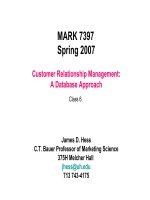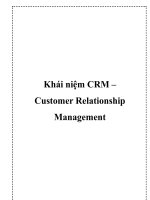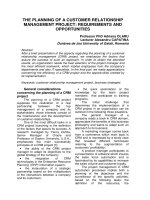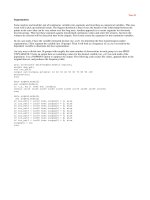1 MARKETING managing profitable customer relationship
Bạn đang xem bản rút gọn của tài liệu. Xem và tải ngay bản đầy đủ của tài liệu tại đây (745.14 KB, 19 trang )
1. MARKETING: Managing Profitable Customer Relationship
Marketing -
Marketing is a social and managerial process by
which individuals and groups obtain what they
need and want through creating and exchanging
products and value with others
COLLEGE OF BUSINESS ADMINISTRATION
CHUNG-ANG UNIVERSITY
PROF HYUNSUK SUH
2
The objectives of the current chapter are described.
Objectives
Be able to define marketing and discuss its core concepts
Understand the marketing process
Be able to understand five(5) marketing management orientations
Understand the strategies for building lasting customer relationships
0. Objectives
3
1. Marketing Definition
What is your definition of “MARKETING”?
Is it for selling
the product?
?
?
Are you talking
about
advertising?
Commercial
transactions?
Or customer
satisfaction?
Trade may be?
Example
4
To explain marketing, let’s take a look at the following example.
Marketing, What’s It All About?
All Those
Bicycles!
Look at the Different Bicycles People Ride!
Things a Firm should do in Producing a Bike
Analyze Needs
Predict Wants
Estimate How Many
Estimate Price
Decide Promotion
Provide Service
1. Marketing Definition
Example
5
The definitions of the marketing are listed below.
What is Marketing?
Marketing is the process of planning and executing the conception, pricing,
promotion, and distribution of ideas, goods, and services to create exchanges
that satisfy individual and organizational goals.
American Marketing Association, 1986
마케팅이란 기업이 최종고객들 ( 소비자들 ) 에게 가능한 한 최대한의 경쟁적 비교우위를 갖
는 가치를 제공해 주기 위해 내부적 고객들 ( 임직원 ) 및 외부적 고객들 ( 유통업체 등 ) 에게
가치 있는 기업으로 인식되도록 운영하는 활동 .
Korean Scholars, 1993
1. Marketing Definition
6
The definitions of the marketing continues.
What is Marketing?
Managing markets to bring about exchanges and relationships for the
purpose of creating value and satisfying needs and wants
Social and managerial process by which individuals and groups obtain what
they need and want through creating and exchanging products and value
with others
Delivering customer satisfaction at a profit
Kotler & Armstrong, 2000
1. Marketing Definition
7
The definitions of the marketing continues.
Kotler’s Social Definition of Marketing
Marketing is a social and managerial process by which individuals and groups
obtain what they need and want through creating and exchanging products and
value with others
Marketing is managing profitable customer relationship
It is attracting new customers and retaining and growing current customers
Kotler & Armstrong, 2008, 2010
Marketing is a process by which companies create value for customers and
build strong customer relationships in order to capture value from customers
in return
Kotler & Armstrong, 2011
1. Marketing Definition
8
The unspecified one to one relationship of marketing in the prehistoric days, passed
through series of evolutions, ending up showing the same fashion today.
1. Marketing Definition
기업에서 제일 중요한 자산은 ‘고객’
고객을 중요도와 충성도에 따라 분류 필요
고객의 공통적인 특징 발견
고객의 과거행동은 미래의 행동을 예측하는 근거
상품판매를 위해서는 고객의 욕구와 매체를 파악
정보통신의 발달
Internet,
PC 통신 ,CATV 등
원시마케팅
원시마케팅
•
Unspecified 1:1
•
Word of mouth
promotion
•
Mass media
•
To many and unspecified individuals
타겟마케팅
타겟마케팅
•
Segment marketing
매스마케팅
매스마케팅
DB 마케팅
DB 마케팅
•
Individualized
•
One to one
•
Relationship
효율적인
단순업무
처리
업무
자동화 ,
생산효율
증대
의사결정
지원
BC 1930 1975 1990
2000
Evolution of Marketing
9
Needs Wants Demands
Products Services
Value Satisfaction Quality
Market
Exchange Relationship
The marketing process is illustrated in following diagram.
1. Marketing Definition
Marketing Process
10
Perceived Value
The customers’ evaluation of the difference between benefits and costs.
Customers often do not judge values and costs accurately or objectively.
Customer Satisfaction
Product’s perceived performance relative to customers’ expectations.
The marketing process is illustrated in following diagram.
Value and Satisfaction
What does
this ad trying
to do?
F
C
11
Production Concept
Product Concept
Selling Concept
Marketing Concept
Societal Marketing
Available and highly affordable
Most in quality, performance,
and innovative features
Sell what they make
rather than make what
the market wants
Creating long-term customer
relationships based on the
customer value and satisfaction
Deliver customer a superior value
that improve customer’s and
society’s well-being
The five(5) important marketing management concepts are described below.
2. Marketing Management Concept
12
The difference between the selling concept and the marketing concept is the process
orientation: one is started from a ‘factory’ while the other started from the ‘customer’.
The Selling Concept vs. Marketing Concept
2. Marketing Management Concept
Starting
Starting
point
point
Focus
Focus
Means
Means
Ends
Ends
Factory
Existing
products
Selling
and
promoting
Profits
through
sales volume
THE SELLING CONCEPT
Market
Customer
needs
Integrated
marketing
Profits through
customer
satisfaction
THE MARKETING CONCEPT
How
so?
13
Society
(Human Welfare)
Consumers
(want satisfaction)
Company
(Profits)
The more advanced form of societal marketing takes into consideration of all three(3)
important factors together: The welfare, profits, and satisfaction.
The Societal Marketing Concept
1. 공해나 환경오염 , 자연환경훼손 ,
자원낭비 , 생태계의 파괴 등
환경보호주의
2. 과소비 , 물질주의 , 정치력행사
로
인한 사회복지 저해
예 ) 기아자동차 로고
2. Marketing Management Concept
Societal
Marketing
Concepts
14
Today, the standards of marketing practice have shifted from an emphasis on
producers’ interests to consumers’ interests and a consideration of the social and
environmental consequences of potential actions.
Ethics
2. Marketing Management Concept
Many marketing issues are not specifically addressed by existing laws and regulations
so many companies, industries, and professional associations have developed codes of
ethics to assist managers.
You know that a considerable amount of food advertising is directed at children between the ages of
6 to 11. A recent findings report on the role of the media in influencing childhood obesity in the
United States. The report concluded that the majority of research finds a direct link between the
amount of time children spend interacting with the media and their body weight. “The report cites
studies showing that the typical American child sees about 40,000 ads a year on television, and that
the majority of ads aimed at children are for sweets, cereal, soda, and fast food.”
QUESTIONS:
1. Do food ads children are exposed to on TV influence them to make unhealthy food choices?
2. Would you support government regulations directed at regulating food ads for children aged
6 to 11?
15
3. Customer is the Key
What is customer equity?
Customer Equity
The combined customer lifetime values of all current and potential customers
Measures a firm’s performance, but in a manner that looks to the future
Choosing the “best” customers is key
Example: Cadillac
In the 1970s and 1980s, Cadillac had some of the most loyal customers in the industry. To
an entire generation of car buyers, the name “Cadillac” defined American luxury. Cadillac’s
share of the luxury car market reached a whopping 51% in 1976. Based on market share
and sales, the brand’s future looked rosy. However Cadillac customers were getting older
(average age 60) and average customer lifetime value was falling. Many Cadillac buyers
were on their last car. Thus, although Cadillac’s market share was good, its customer
equity was not. Compare this with BMW. Its more youthful and vigorous image didn’t win
BMW the early market share war. However it did win BMW younger customer with
higher . . . . . . . . . .
16
3. Customer is the Key
Test yourself with the following concepts.
Concept Check
1. The two very important marketing theme for today is to
_________________ and _________________ .
2. Based on _________________ concept, even if your customers had bad
experiences with your product, if you do well on your sales part, they will forget
about the terrible memories and repurchase will occur.
3. Although the customers belong to the _________________ groups have long
term relationship with your company, they do not bring good profits.
4. An organization can’t satisfy the needs of all the customers, so it must focus on
one or more of subgroups, which are its _________________ .
17
Consider the following issues.
5. Discussions
End of Chapter Discussions
Discussion
DISCUSS THE FOLLOWING TOPICS
1. What consumer wants (or benefits) are met by the following products or services?
(a) Breakfast Cereal, (b) Adidas running shoes, (c) Hertz Rent-A-Car, and
(d) television home shopping programs.
2. Each of the four products, services, or programs in question 1 has substitutes.
Respective examples are
(a) a ham and egg breakfast, (b) regular tennis shoes,
(c) taking a bus, and (d) a department store.
What consumer benefits might these substitutes have in each case that some
consumers might value more highly than those products mentioned in question 1?
3. A college in a metropolitan area wishes to increase its evening-school offerings of
business-related courses such as marketing, accounting, finance, and management.
Who are the target market customers (students) for these courses?
18
In 1990, Allergan was just a small specialty pharmaceutical firm selling little-known eye
and skin drugs and over-the-counter contact lens cleaners. The introduction of Botox
wasn’t such a big deal initially. After all, typical Allergan specialty products, it was just
another specialty drug aimed at a small market (treatment of cross-eye). That was before
doctor discovered that injecting Botox around eyes not only eliminated ocular problems, it
erased frown lines as well. Once that happened, the doctors in most major US cities were
giving patients off-label (not approved by the FDA for this use) Botox injections. Even
though Allergan could not openly market the product for cosmetic purposes, by 2001 sales
of Botox was rocketed to $310 million and were growing between 25~35% per year. FDA
approval granted in April 2002, only accelerated this sales bonanza. With all those target
markets could become a blockbuster drug!
The side effects of Botox can be the loss of facial expressions (however this may be a
positive effect for some business people), drooping eyelids when injected on foreheads and
around eyes (but this could also give you somewhat sexy looks). Botox can cause slurred
speech, nausea, headaches, respiratory infections, and constant drooling. However,
because Botox cosmetic lasts only 3~6 months all side effects are temporary.
Discuss the following problem.
Botulinum Toxin A - page 1 of 2
6. Exercise
Homework
19
Discuss the following problem.
Botox has become so lucrative and the demand so great that the treatments are
sometimes offered in a party atmosphere. Doctors usually ask a current patient to invite
10~15 prospective clients to a party at his or her home. After a brief social period, the
doctor gives a short lecture on Botox and invites the partygoers to sign up for treatment.
Patients take turns leaving the room, and the doctor gives the injections in private. Parties
provide a non-clinical atmosphere more conductive to patient receptivity, and reduce time
and cost. The doctors can give patients a price break up to 25% of the original cost.
Q1. What are the needs, wants, and demands of consumers of Botox products in its
different treatment markets? What value does Botox deliver in each market?
Q2. When Allergan sold Botox as a specialty drug for ocular problems, what marketing
management orientation was it employing? When it sells Botox as a cosmetic treatment, is
it employing the same or different orientation?
Q3. When doctors treat patients with Botox in their office, is that an example of selling
concept or marketing concept? Which concept applies when they hold parties for patients
in their private homes?
Botulinum Toxin A - page 2 of 2
6. Exercise
Homework









